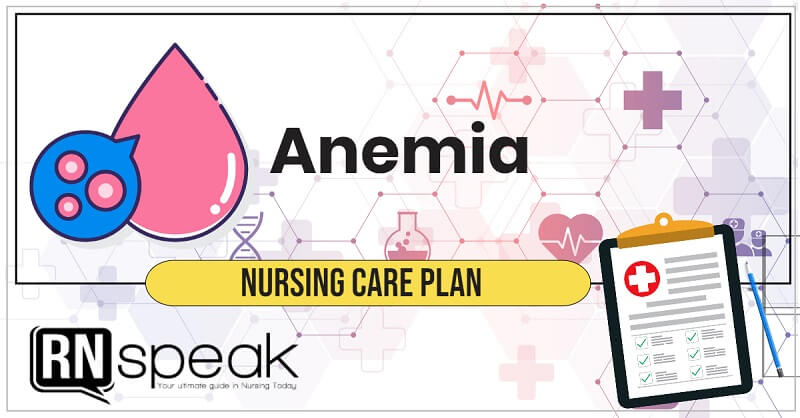Anemia is a widespread condition that affects people of all ages whether children or adults, with significant implications for health and well-being. Defined as a reduction in the number of red blood cells (RBCs), anemia can lead to insufficient oxygen delivery to vital organs, resulting in symptoms such as fatigue, weakness, and shortness of breath. While some cases may be mild and go unnoticed, others can be severe and life-threatening.
According to WHO, estimated anemia affects 40% of children aged 6 to 59 months, 37% of pregnant women, and 30% of women aged 15 to 49 globally.
For nurses, creating a comprehensive care plan for patients with anemia is important. Such a plan not only addresses the immediate symptoms but also investigates the underlying causes, which can range from nutritional deficiencies to chronic diseases. By understanding the specific needs of each patient and implementing targeted interventions, nurses can play a crucial role in improving outcomes and enhancing the quality of life for individuals affected by this condition.
Wondering what might be the nursing problems you would encounter for a patient with anemia? Look no further because, in this article, we will feature what is anemia and some nursing care plans that nurses can utilize based on the identified problems of their patient diagnosed with anemia.
The etiology of anemia depends on whether the anemia is hypoproliferative or hyperproliferative.
Hypoproliferative Anemia
Hypoproliferative anemia results from the inability of the bone marrow to produce adequate numbers of RBCs. Hypoproliferative anemias are further divided by mean corpuscular volume into microcytic anemia (MCV <80 fl), normocytic anemia (MCV 80-100 fl), and macrocytic anemia (MCV >100 fl). The following are diseases associated with this type of anemia.
- Hypoproliferative Microcytic Anemia
- Iron deficiency anemia
- Anemia of chronic disease
- Sideroblastic anemia
- Thalassemia
- Lead poisoning
- Hypoproliferative Normocytic Anemia
- Anemia of chronic disease
- Renal failure
- Aplastic anemia
- Pure red cell aplasia
- Myelofibrosis or myelophthisic processes
- Multiple myeloma
- Hypoproliferative Macrocytic Anemia
- Alcohol
- Liver disease
- Hypothyroidism
- Folate and vitamin B12 deficiency
- Myelodysplastic syndrome
- Drug-induced
- Hemolytic Anemia
- Hemoglobinopathies (Sickle cell, thalassemias)
- Enzymeopathies (G6PD deficiency, pyruvate-kinase deficiency)
- Membrane defects (hereditary spherocytosis, hereditary elliptocytosis)
- Drug-induced
Anemia is a condition where there is a lower than normal number of red blood cells (RBCs), which reduces the blood’s ability to carry oxygen. The reasons for occurrence of anemia are complex and depend on various underlying factors. It can occur due to:
Decreased RBC Production: This can happen if the body doesn’t produce enough RBCs, often due to nutritional deficiencies, such as lack of iron, vitamin B12, or folate.
Increased RBC Destruction: Conditions like hemolytic anemia cause the body to destroy RBCs faster than they can be made.
Blood Loss: Significant bleeding from injuries, surgery, or chronic conditions like ulcers can lead to anemia.
The way anemia affects the body also varies with how quickly it develops. If it occurs gradually, the body may adapt to ensure adequate oxygen delivery. However, in cases of sudden blood loss, there is an immediate drop in both the amount of oxygen carried in the blood and the overall blood volume. This can lead to symptoms like insufficient oxygen reaching tissues (hypoxia) and low blood volume (hypovolemia), which may cause low blood pressure (hypotension). The body senses this drop in pressure through specialized receptors in areas like the carotid artery and heart, triggering responses to stabilize blood flow and pressure.
The prognosis for individuals with anemia largely depends on its underlying cause, severity, and rate of onset. Rapidly developing anemia may pose more significant health risks compared to slower-onset forms that allow for compensatory mechanisms.
For nurses caring for patients with anemia, establishing an accurate diagnosis is important for selecting appropriate interventions. Common nursing diagnoses associated with anemia include fatigue related to decreased oxygenation and risk for decreased cardiac output due to hypovolemia. Effective nursing interventions focus on identifying the etiology of anemia—whether it is related to nutritional deficiencies, chronic disease processes, or acute blood loss—to tailor treatment plans that address both symptoms and root causes.
The following are nursing diagnoses associated with anemia.
- Activity Intolerance
- Imbalanced Nutrition: Less than Body Requirements
- Risk for Infection
- Fatigue
Anemia Nursing Care Plan
Below are sample nursing care plans for the problems identified above.
Activity Intolerance
Clients diagnosed with anemia could have symptoms of weakness, fatigue, poor work productivity, or difficulty concentrating. The mechanisms are mainly due to a decreased maximal oxygen uptake and diminished oxygen carrying capacity, which is the major cause of reduced exercise capacity as well. Physiologically, the main function of RBCs is to transport oxygen from the lungs to the peripheral tissues and deliver metabolically produced carbon dioxide to the lungs for expiration. When the level of hemoglobin drops remarkably, the oxygenation of extremity skeletal muscles is reduced, possibly impairing physical performance in advance.
Nursing Diagnosis
- Activity Intolerance
Related Factors
- Imbalance between oxygen supply or delivery and demand
Evidenced by
- Weakness and fatigue
- Statements of decreased exercise or activity intolerance
- Increased need for sleep or rest
- Tachycardia
- Hypertension
- Exertional dyspnea
Desired Outcomes
- The client will report an increase in activity tolerance, including activities of daily living (ADLs).
- The client will demonstrate a decrease in physiological signs of intolerance with vital signs within the normal range.
- The client will display laboratory values within the acceptable range.
Nursing Interventions
| Assessment | Rationale |
| Assess the client’s ability to perform normal tasks and ADLs. | Note the client’s reports of weakness, fatigue, and difficulty accomplishing tasks because this influences the choice of interventions and needed assistance. |
| Assess changes in balance, gait disturbance, and muscle weakness. | This may indicate neurological changes associated with vitamin B12 deficiency, affecting client safety and increasing the risk of injury. |
| Monitor vital signs during and after an activity. | Cardiopulmonary manifestations result from attempts by the heart and lungs to supply adequate amounts of oxygen to the tissues. Observe for adverse responses to increased levels of activity such as tachycardia, hypertension, dysrhythmias, dizziness, dyspnea, tachypnea, and cyanosis of mucous membranes and nailbeds. |
| Independent | |
| Provide a quiet environment and bedrest as indicated. | Limit the client’s visitors, phone calls, and unplanned interruptions. Activity may need to be curtailed until severe anemia is at least partially corrected to lower the body’s oxygen requirements and reduce the strain on the heart and lungs. |
| Elevate the head of the bed as tolerated. | This enhances lung expansion to maximize oxygenation for cellular uptake. However, this may be contraindicated in clients with hypotension because it may exacerbate the feeling of lightheadedness. |
| Encourage careful position changes. | Postural hypotension or cerebral hypoxia may cause dizziness, fainting, and increased risk for injury. |
| Assist the client to prioritize ADLs and desired activities. Alternate rest periods with activity periods. | This promotes adequate rest, maintains energy level, and alleviate strain on the cardiac and respiratory systems. Clients with severe anemia should curtail their activity until the anemia is partially corrected . |
| Encourage frequent ambulation and participation in activities with assistance, as appropriate. | This allows the client to still be active as much as possible. Although help may be necessary, self-esteem is enhanced when the client does things for themselves. |
| Plan activity progression with the client, including activities that the client views as essential. Increase activity levels as tolerated. | This promotes a gradual return to normal activity levels and improved muscle tone and stamina without undue fatigue. This also increases self-esteem and a sense of control. |
| Identify and implement energy-saving techniques such as shower chairs and sitting to perform tasks. | This encourages the client to do as many activities as possible while conserving limited energy and preventing fatigue. |
| Instruct the client to stop an activity if palpations, chest pain, shortness of breath, weakness, or dizziness occur. | Cellular ischemia potentiates the risk of infarction, and excessive cardiopulmonary strain and stress may lead to decompensation and failure. |
| Discuss the importance of maintaining environmental temperature and body warmth as indicated. | Vasoconstriction with shunting of blood to vital organs decreases peripheral circulation, impairing tissue perfusion. The client’s comfort and need for warmth must be balanced with the need to avoid excessive heat with resultant vasodilation, which reduces organ perfusion. |
| Dependent/Collaborative | |
| Monitor laboratory studies. | This identifies deficiencies in RBC components affecting oxygen transport, treatment needs, and response to therapy. The WHO criterion for anemia in adults is a hemoglobin value of less than 12.5 g/dl. Children aged 6 months to 6 years are considered anemic at Hb levels less than 11 g/dl. |
| Provide supplemental oxygen as prescribed. | Maximizing oxygen transport to tissues improves the ability to function. Hyperbaric oxygen therapy can increase oxygen delivery to the tissues and relieve the signs and symptoms of oxygen debt. |
| Administer blood and blood products as prescribed. | Blood transfusion increases the number of oxygen-carrying cells; corrects deficiencies to reduce the risk of hemorrhage in acutely compromised individuals. However, transfusions are reserved for severe blood loss anemias with cardiovascular compromise and are used after other therapies have failed to restore homeostasis. |
| Administer erythropoiesis-stimulating therapies. | Large-scale clinical studies have shown the effectiveness of EPO in increasing erythrocyte and hemoglobin levels, relieving clinical and quality-of-life manifestations associated with anemia of chronic disease. |
| Prepare and assist in surgical interventions, if necessary. | Surgery is useful to control bleeding in clients who are anemic because of bleeding, such as in ulcers and uterine bleeding. Splenectomy is useful in the treatment of autoimmune hemolytic anemias and in certain hereditary hemolytic disorders. |
Imbalanced Nutrition: Less than Body Requirements
Nutritional anemia is the most prevalent nutritional disorder in the world. According to WHO reports, 24.8% of the global population is anemic due to an imbalance in their food intake. In a healthy person, a state of nutritional balance exists: the amount of food eaten is equal to the number of nutrients for the proper functioning of the body. This imbalance is due to a decrease in nutrition, an increase in losses, increased needs, decreased absorption, and decreased utilization. It is the result of a deficiency of one or more essential nutrients in the body, especially iron. When these are exhausted, all the bodily functions in which this nutrient plays a part are affected.
Nursing Diagnosis
- Imbalanced Nutrition: Less than Body Requirements
Related Factors
- Failure to ingest the proper amount of nutrients
- Inability to digest food or absorb nutrients
Evidenced by
- Weight loss or weight below normal for age, height, and build
- Decreased triceps skinfold measurement
- Changes in gums or oral mucous membranes
- Decreased tolerance for activity
- Weakness
- Loss of muscle tone
Desired Outcomes
- The client will demonstrate progressive weight gain or stable weight.
- The client will display normal values of laboratory tests.
- The client will experience no signs of malnutrition.
- The client will demonstrate behaviors or lifestyle changes to regain and maintain an appropriate weight.
Nursing Interventions
| Assessment | Rationale |
| Weigh the client periodically. | This monitors weight loss and the effectiveness of nutritional interventions. Changes in body weight are important with regard to dietary intake and can suggest the presence of malabsorption or an underlying wasting disease of infectious, metabolic, or neoplastic origin. |
| Observe and record the client’s food intake. | This monitors caloric intake or insufficient quality of food consumption. Clients with iron deficiency frequently chew or suck ice (pagophagia). |
| Review nutritional history, including food preferences. | A thorough dietary history is important for a client who is anemic. This history must include foods that the client eats and those that they avoid, as well as an estimate of their quantity. A meal-by-meal description is necessary to obtain appropriate estimates. |
| Independent | |
| Provide small, frequent meals and between-meal nourishment. | This may reduce fatigue and thus enhance intake while preventing gastric distention. Use of Ensure, Isomil, or similar products provides additional protein and calories. |
| Promote a bland diet, low in roughage, avoiding hot, spicy, or very acidic foods, as indicated. | When oral lesions are present, pain may restrict the type of food that the client can tolerate. Clients diagnosed with folate deficiency may have a sore tongue and cheilosis. In vitamin B12 deficiency, a burning sensation in the tongue is common. |
| Encourage the client to record and report the occurrence of nausea or vomiting, flatus, and other related symptoms, such as irritability or impaired memory. | These symptoms may reflect the effects of anemia, such as hypoxia or vitamin B12 deficiency, on organs. |
| Encourage or assist with good oral hygiene before and after meals. | Good oral hygiene enhances appetite and oral intake and diminishes bacterial growth thereby minimizing the possibility of infection. Special mouth care techniques may be needed if tissue is fragile, ulcerated, or bleeding and pain are severe. A soft-bristled toothbrush and alcohol-free mouthwash may be used. |
| Dependent/Collaborative | |
| Consult or refer to a dietitian. | This aids in establishing a dietary plan to meet individual needs. |
| Monitor laboratory studies. | Often, the etiology of the client’s anemia can be determined if the RBCs are altered in either size or shape or if they contain certain inclusion bodies. Every client with iron deficiency anemia should have a stool exam for occult blood. A client with anemia without evidence of bleeding or iron deficiency, with normal indirect bilirubin and normal or decreased reticulocyte count, probably has a defect in the production of erythrocytes . |
| Administer vitamin and mineral supplements, such as cyanocobalamin, folic acid, and ascorbic acid, as prescribed. | Vitamin and mineral supplements are replacements needed depending on the type of anemia and the presence of poor oral intake and identified deficiencies. |
| Administer iron supplements such as ferrous sulfate, ferrous gluconate, and ferrous fumarate, as prescribed | These supplements may be useful in some types of iron deficiency anemias. Oral preparations are taken between meals to enhance absorption and usually correct anemia and replace iron stores over a period of several months. |
| Administer IM iron dextran as indicated. | Iron dextran complex replenishes depleted iron stores in the bone marrow, where it is incorporated into hemoglobin. Parenteral use of iron-carbohydrate complexes has caused anaphylactic reactions, and its use should be restricted to clients with an established diagnosis of iron deficiency anemia whose anemia is not corrected with oral therapy. |
| Administer antifungals or an anesthetic mouthwash, if indicated. | These may be needed in the presence of stomatitis or glossitis to promote oral tissue healing and facilitate intake. |
Risk for Infection
Iron deficiency is thought to impair immunity by negatively influencing cell-mediated immunity and components of the human innate immune system. For example, iron deficiency has also been associated with thymic atrophy, the depression of t-lymphocytes, decreased neutrophil function, a decrease in the microbial qualities of macrophages, and reduced interleukin-2 production by activated lymphocytes. Besides being an essential element for human metabolism, iron is also an important nutrient for pathogenic microorganisms.
Nursing Diagnosis
- Risk for Infection
Related factors
- Decreased hemoglobin
- Leukopenia
- Decreased granulocytes
- Broken skin or stasis of body fluids
- Invasive procedures
- Chronic disease or malnutrition
Evidenced by
- [Not applicable; the presence of signs and symptoms establishes an actual diagnosis]
Desired Outcomes
- The client will identify behaviors to prevent and reduce the risk of infection.
- The client will be free of signs of infection.
- The client will achieve timely wound healing if present.
Nursing Interventions
| Assessment | Rationale |
| Monitor temperature. Note the presence of chills and tachycardia. | These signs are reflective of inflammatory processes or infection, requiring evaluation and treatment. With bone marrow suppression, leukocytic failure may lead to fulminating infections. |
| Observe for wound erythema and drainage. | These are indicators of local infection. Pus formation may be absent if granulocytes are depressed. |
| Independent | |
| Perform and promote meticulous hand washing by caregivers and clients. | Hand hygiene prevents cross-contamination or bacterial colonization. A client with severe or aplastic anemia may be at risk from normal skin flora. |
| Maintain strict aseptic techniques with procedures and wound care. | The aseptic technique reduces the risk of bacterial colonization and infection. |
| Provide meticulous skin, oral, and perianal care. | This reduces the risk of skin or tissue breakdown and infection. |
| Encourage frequent position changes and ambulation, coughing, and deep-breathing exercises. | These interventions promote ventilation of all lung segments and aid in mobilizing secretions to prevent pneumonia. |
| Promote adequate fluid intake. | This assists in liquefying respiratory secretions to facilitate expectoration and prevent stasis of body fluids in the lungs and bladder. |
| Emphasize the need to monitor and limit visitors. Provide protective isolation if indicated. | This limits exposure to infectious agents. Protective isolation may be required in aplastic anemia when the immune response is most compromised. Restrict live plants and cut flowers which may harbor harmful pathogens. |
| Dependent/Collaborative | |
| Obtain specimens for culture and sensitivity, as indicated. | This verifies the presence of infection, identifies specific pathogens, and influences the choice of treatment. |
| Administer topical antiseptics and systemic antibiotics as prescribed. | These may be used prophylactically to reduce colonization or used to treat specific infectious processes. |
| Administer pneumococcal vaccine as indicated. | If a client is scheduled for splenectomy, they should be immunized with the polyvalent pneumococcal vaccine. Preferably, this should be administered more than one week prior to surgery. |
Fatigue
Fatigue in clients with anemia primarily results from a decrease in the oxygen-carrying capacity of the blood. Anemia is characterized by a lower-than-normal number of red blood cells (RBCs) or hemoglobin levels. Hemoglobin is the protein in RBCs responsible for transporting oxygen from the lungs to the body’s tissues. When hemoglobin levels are low, less oxygen is delivered to the tissues, leading to fatigue and weakness as the body’s cells do not receive the energy they need to function effectively. In addition, the deficiency of RBCs means that organs and muscles receive inadequate oxygen, which is crucial for energy production. This results in feelings of tiredness and decreased stamina during physical activities
Nursing Diagnosis
Fatigue
Risk Factors
- Decreased hemoglobin levels
- Nutritional deficiencies (iron, vitamin B12, folate)
- Chronic blood loss (e.g., gastrointestinal bleeding, heavy menstruation)
- Increased demand (e.g., pregnancy, growth spurts)
- Malabsorption syndromes
Evidenced by
- Reports of fatigue and weakness
- Pale skin and mucous membranes
- Shortness of breath on exertion
- Dizziness or lightheadedness
Desired Outcomes
- The client will report increased energy levels and reduced fatigue.
- The client will maintain hemoglobin levels within the normal range.
- The client will verbalize understanding of dietary modifications to improve iron intake.
Nursing Interventions
| Assessment | Rationale |
| Assess vital signs, including heart rate and blood pressure. | Monitoring vital signs helps identify signs of hypoxia or cardiovascular stress due to anemia.
|
| Assess the patient’s level of fatigue and ability to perform activities of daily living (ADLs). | This helps establish a baseline for fatigue levels and identifies specific limitations, allowing for tailored interventions to improve energy management. |
|
Monitor hemoglobin and hematocrit levels regularly |
Regular monitoring evaluates the effectiveness of treatment interventions.
|
| Assess for signs of bleeding (e.g., dark stools, vomiting blood). | Identifying potential sources of chronic blood loss is vital for managing anemia effectively.
|
| Independent | |
| Encourage the patient to prioritize activities and balance rest with activity.
|
Prioritizing tasks helps manage energy levels effectively, allowing the patient to complete essential activities without exacerbating fatigue. |
| Assist the patient in developing a daily activity plan that includes scheduled rest periods. | A structured plan can help prevent overwhelming fatigue by ensuring that the patient has adequate time to rest between activities, promoting better energy conservation. |
| Facilitate gentle physical activity as tolerated (e.g., walking or light stretching). | Encouraging moderate exercise can help maintain muscle strength and improve overall energy levels without causing excessive fatigue |
|
Encourage a diet rich in iron (e.g., red meat, leafy greens, legumes). |
Dietary changes can help improve iron levels in the blood and overall nutritional status.
|
| Educate the client about vitamin C’s role in enhancing iron absorption. | Vitamin C enhances the bioavailability of non-heme iron from plant sources. |
|
Monitor for side effects of iron supplements (e.g., gastrointestinal upset, constipation). |
Early identification of side effects allows for timely interventions or adjustments in therapy.
|
| Encourage hydration and fiber intake to prevent constipation associated with iron supplements. | Adequate hydration and fiber can mitigate gastrointestinal side effects from iron supplements. |
|
Provide education on the importance of adhering to prescribed therapy. |
Understanding the treatment plan increases compliance and improves outcomes.
|
| Dependent/Collaborative | |
| Administer oral iron supplements as prescribed. | Iron supplements can directly increase serum iron levels and improve hemoglobin synthesis. |
| Collaborate with a dietitian for personalized meal planning if necessary.
|
A dietitian can provide tailored nutritional advice to enhance iron intake and absorption that will help improve the body’s energy,
|
References:
- Anaemia. Retrieved October 1, 2024, from Who.int website: https://www.who.int/health-topics/anaemia
- Gulanick, M., & Myers, J. L. (2017). Nursing care plans: Diagnoses, interventions, & outcomes. Mosby.
- Hinkle, J. L., & Cheever, K. H. (2014). Brunner & Suddarth’s textbook of medical-surgical nursing (Edition 13.). Wolters Kluwer Health/Lippincott Williams & Wilkins.
- Safiri, S., Kolahi, A. A., Noori, M., Nejadghaderi, S. A., Karamzad, N., Bragazzi, N. L., Sullman, M. J. M., Abdollahi, M., Collins, G. S., Kaufman, J. S., & Grieger, J. A. (2021). Burden of anemia and its underlying causes in 204 countries and territories, 1990-2019: results from the Global Burden of Disease Study 2019. Journal of hematology & oncology, 14(1), 185. https://doi.org/10.1186/s13045-021-01202-2





![[Stroke] Cerebrovascular Accident Nursing Care Plan cerebrovascular accident nursing care plan](https://rnspeak.com/wp-content/uploads/2021/03/CVA-nursing-care-plan-238x178.jpg)


